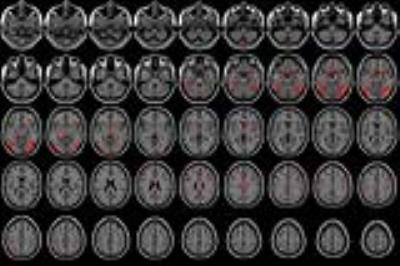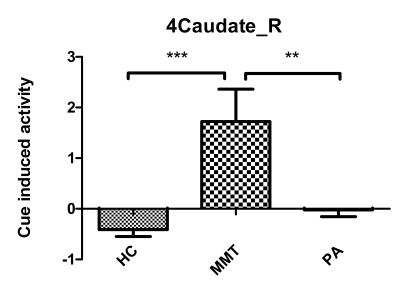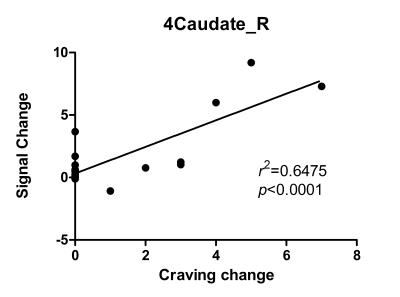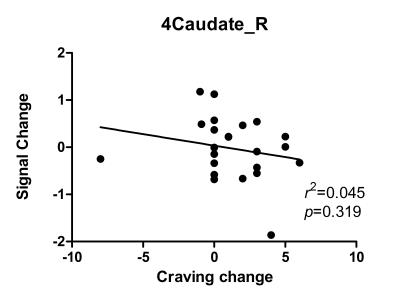5382
Cue-Induced reactivity of brain in abstinence and methadone maintenance treatment for heroin addiction: an event-related functional magnetic resonance imaging study1Radiology department of Tangdu hospital, The Fourth Military Medical University, Xi'an, People's Republic of China, 2Radiology department of Tangdu hospital, The Fourth Military Medical University, People's Republic of China
Synopsis
Purpose Our research aims to research abstinence and methadone maintenance treatment, to reveal which abstinence way is better and to compare their cue-reactivity in heroin-dependent individuals.
Materials and Methods 24 heroin-dependent patients under abstinence,19 heroin-dependent patients under MMT and 20 healthy volunteers were recruited. The functional images were acquired by using a spin-echo EPI.
Results MMT group brain regions which had differences in cue-reactivity intensity were significantly positive correlation with craving changes, and abstinence group did not exist. Discussion and Conclusion This study showed that abstinence is more advantageous than MMT to reduce heroin addiction in drug cue-reactivity.
Target audience
Researchers who use functional magnetic resonance imaging (fMRI) to research on heroin addict brains.Purpose
As MRI technique improving, fMRI is considered as the most sensitive method for early pathological changes. In order to obtain good curative effect, we compared abstinence with methadone maintenance treatment (MMT). We combined fMRI and a drug cue-reactivity task to explore abstinence and MMT for heroin addicts under the drug cue-reactivity task and the differences between craving and brain effects, and to evaluate the curative effect of these two methods in treatment. Task-based studies have demonstrated that a certain part of default mode network such as medial prefrontal cortex, is closely associated with drug craving and relapse [1, 2]. An event-related cue-reactivity paradigm was employed. However, which abstinence way is better and what is the relationship between drug cue-reactivity of the abstinence ways and heroin-dependent individuals remain unknown. Our research aims to reveal the answers to these two questions.Materials and Methods
24 heroin-dependent male patients under abstinence,19 heroin-dependent male patients under MMT(average daily dose 38.7±17.1mg), and 20 healthy male volunteers were recruited. All the subjects were smokers. MMT group subjects stopped smoking heroin immediately upon entering the program and received MMT right away. The patients’ subjective craving was evaluated. And the healthy volunteers also performed the heroin cue-reactivity task during fMRI, same as the other two groups. Subjects inclusion criteria included: meeting the diagnostic criteria of DSM-IV (Diagnostic and Statistical Manual of Mental Disorders, Fourth Edition) for heroin addiction; under abstinence for 6 months and under MMT for 6 months with a stable dose for at least 1 month before baseline; adult male and right-handed; normal control subjects had no current or lifetime history of any DSM-IV substance use or psychiatric disorder. A routine structure T2WI image was conducted to exclude any gross cerebral abnormality. The functional component of the image was acquired by using a spin-echo EPI (echo planar imaging) with the following parameters: For each volume, 32 axial slices covering the whole brain were acquired with the following parameters: repetition time = 2000 milliseconds, echo time = 30 milliseconds, flip angle = 90°,matrix = 64×64, field of view = 256×256 mm2, slice thickness = 4 mm, gap = 0 mm, spatial resolution = 4×4×4 mm3. To facilitate co-registration of the fMRI data in standard space, a 166-slice high-resolution fast spoiled gradient-echo 3D T1-weighted image was also collected with the following parameters Data Processing Assistant for fMRI (DPARSF) within Matlab software was used in the data preprocessing process of the functional images. The fMRI data analysis was conducted with SPM8 software .The functional scans were realigned to the first image with the volume of 150, and head motion correction was processed to get the corresponding mean functional image. The images were normalized with the voxel size of 3 × 3 × 3 mm by using an EPI template and spatially smoothed with a FWHM of 8 mm.Results
Under the condition of heroin-related > neutral cues, MMT group, abstinence group and healthy group in drug cues have a statistically significant difference in terms of the response in the following brain areas: bilateral fusiform, bilateral hippocampus, right caudate nucleus, right super parietal, middle cingulate gyrus cortex, right dorsolateral prefrontal cortex, left inferior parietal lobe. Post hoc analysis showed that MMT group were significantly enhanced in cue-reactivity in the above brain regions than abstinence group and healthy group; compared with healthy group, abstinence group had no statistical differences in the brain regions. MMT group brain regions which had differences in cue-reactivity intensity were significantly positive correlation with craving changes, and abstinence group did not exist.Discussion and Conclusion
With the development of neuroimaging technology, a growing number of studies suggested aberrant brain functional on the basis of task-state fMRI data acquired in different stimulus paradigms [3] , especially drug cue-reactivity task which use drug cue-induced craving and neural correlates in the human brain [4].This study further suggested that MMT group brain regions which have differences in cue-reactivity intensity was significantly positive correlation with craving changes, but abstinence group did not exist. In addition, drug cue-reactivity of abstinence group closed to healthy group. These brain regions are related to reward, inhibitory control , stimulus-driven attention and emotional learning circles, which are important to research drug addiction [5] .This study showed that abstinence is more advantageous than MMT to reduce heroin addiction in drug cue-reactivity, which can reduce dominant value in drug cue for heroin addiction, thus reduce the relapse susceptibility of the heroin addicts.Acknowledgements
No acknowledgement found.References
1. Seo, D, et al. Disrupted ventromedial prefrontal function, alcohol craving, and subsequent relapse risk. JAMA Psychiatry, 2013,70(7):727-39.
2. Janes, A.C, et al. Brain reactivity to smoking cues prior to smoking cessation predicts ability to maintain tobacco abstinence. Biol Psychiatry,2010,67(8):722-9.
3. Ma N, Liu Y, Li N, et al. Addiction related alteration in resting-state brain connectivity. Neuroimage,2010, 49:738–744.
4. Qiang Li, Yarong Wang, Yi Zhang et al. Craving correlates with mesolimbic responses to heroin-related cues in short-term abstinence from heroin: An event-related fMRI study. Brain Res.2012,21(8):1469:63-72.
5. Volkow ND, Li T-K .Drug addiction: the neurobiology of behaviour gone awry. Nat Rev Neurosci,2004, 5:963–970.
Figures



